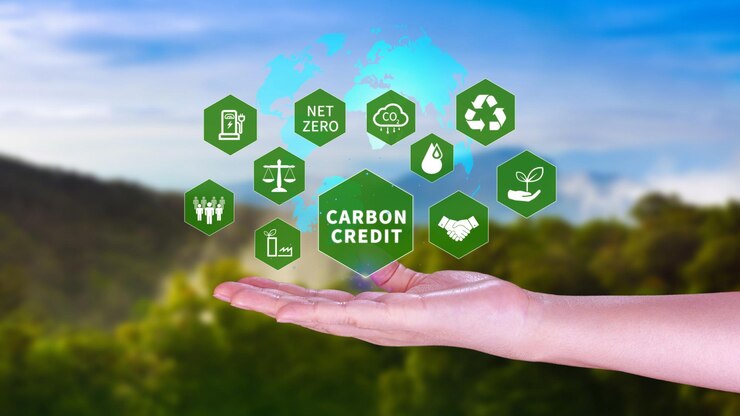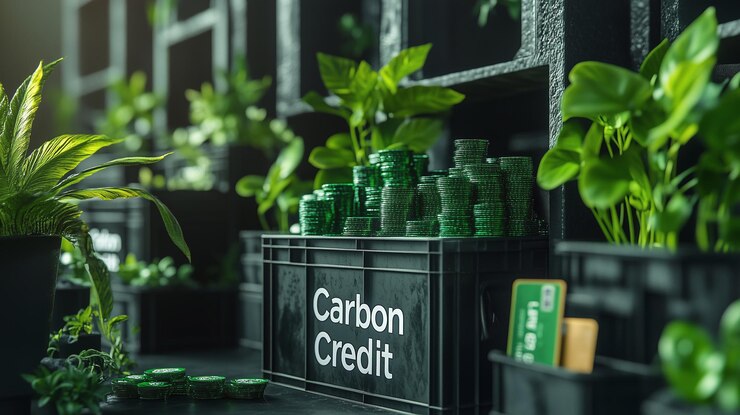Carbon Credits 101
A Beginner's Guide for Businesses

Imagine a world where every ton of carbon dioxide you cannot avoid releasing into the atmosphere comes with a solution, a way to balance the scales and contribute to a healthier planet. For businesses today, that solution often comes in the form of carbon credits. If you have heard the term buzzing around boardrooms or sustainability conferences but are not quite sure what it means, you are in the right place. This beginner's guide will break down carbon credits, why they matter for your business, and how you can get started, without the jargon overload!
What Are Carbon Credits, Anyway?
Let’s start with the basics. A carbon credit is like a permission slip for emitting one ton of carbon dioxide or its equivalent in other greenhouse gases, measured as CO2e. But here is the twist: it is not just about permission, it is about offsetting. One carbon credit represents a ton of CO2 that has been either avoided, reduced, or removed from the atmosphere through a certified project, such as planting trees, building wind farms, or capturing methane from landfills. Businesses buy these credits to compensate for their own emissions, essentially investing in global climate action.
Think of it like this: your company might run a factory that emits 10,000 tons of CO2 annually. Cutting emissions entirely could be a long, costly process, or even impossible with current technology. By purchasing 10,000 carbon credits, you are funding projects elsewhere that neutralize that impact, helping you move toward net-zero goals. This system operates through two main markets: the compliance market, regulated by governments, and the voluntary market, where businesses opt in on their own terms. With global carbon markets growing, projected to hit 50 billion dollars by 2030, it is a trend you cannot ignore.
Why Should Businesses Care?
You might be wondering, why bother with this? The answer lies in a mix of necessity and opportunity. First, regulations are tightening. Countries like the EU, Canada, and soon Malaysia with its 2025 emissions trading system are enforcing carbon pricing and caps, meaning non-compliance could hit your bottom line with fines. Second, consumers and investors are watching. A 2024 survey found that 66 percent of consumers prefer brands with strong environmental commitments, while companies engaging in high-quality carbon offsetting saw a 21 percent boost in investor confidence, per McKinsey. Ignoring carbon credits could mean losing market share.
Beyond compliance and reputation, carbon credits offer a strategic edge. They fund innovative projects, renewable energy installations or reforestation efforts, that align with your ESG, Environmental, Social, Governance, goals. For instance, a tech firm might support a solar project in Africa, gaining co-benefits like community development while offsetting its data center emissions. It is a win-win: you reduce your environmental footprint while enhancing your brand as a sustainability leader.
How Do Carbon Credits Work?

The mechanics are surprisingly straightforward. It all starts with a project, say, a wind farm in India or a reforestation initiative in Brazil. These projects are designed to cut emissions beyond what would happen naturally, a concept called additionality. Independent verifiers, like the Gold Standard or Verra, ensure the reductions are real, measurable, and permanent. Once approved, each ton of CO2 saved or removed becomes a carbon credit, tracked on a registry to prevent double-counting.
Businesses then buy these credits through brokers, marketplaces, or direct partnerships with project developers. The cost varies widely: nature-based solutions, like tree planting, might range from 20 to 50 dollars per credit, while tech-based solutions, like carbon capture, can hit 100 to 500 dollars due to higher development costs. After purchase, you retire the credits, meaning they are used up and cannot be resold, proving your offset commitment. This process ties into frameworks like the Paris Agreement’s Article 6, which standardizes international carbon trading, ensuring your investment supports global climate goals.
The Benefits: More Than Just a Trend
Diving into carbon credits is not just about ticking a box, it is about building a future-proof business. For starters, it complements your decarbonization efforts. Even the greenest companies struggle to eliminate all emissions, think supply chain logistics or product use. Carbon credits bridge that gap, letting you claim carbon neutrality or net-zero status when paired with internal reductions. The Science-Based Targets initiative, SBTi, even encourages using removal credits for the last 10 to 30 percent of emissions by 2050.
Then there is the financial upside. By investing early, you can secure credits at lower prices before demand spikes, turning a cost into a strategic asset. Plus, it opens doors to green financing: banks and investors increasingly favor companies with robust climate strategies. A beauty brand funding clean cookstove projects in rural areas might attract eco-conscious customers while supporting women’s empowerment, a double dose of goodwill.
The Challenges: Navigating the Pitfalls
It is not all smooth sailing, though. Carbon credits have faced criticism, and for good reason. One big concern is greenwashing: some companies buy cheap, low-quality credits from dubious projects, exaggerating their climate impact. The risk of over-crediting, claiming more reductions than actually achieved, or leakage, shifting emissions elsewhere, can undermine credibility. A 2022 study noted that only about 40 percent of voluntary market projects met strict additionality standards, highlighting the need for due diligence.
Another hurdle is cost. For small businesses, the upfront investment might strain budgets, especially with premium credits. And while the market is growing, it is still immature: prices fluctuate, and regulatory shifts, like the EU’s Omnibus Update in 2025, can create uncertainty. Critics also argue that credits let polluters off the hook, delaying the tough work of cutting emissions at the source. The key? Use credits as a tool, not a crutch, alongside aggressive internal reductions.
Getting Started: Your Action Plan

Ready to jump in? Here is a step-by-step guide to make it manageable:
1. Assess Your Footprint: Calculate your emissions across Scope 1, direct, Scope 2, purchased energy, and Scope 3, supply chain. Tools like the GHG Protocol or software from Greenly can help. This tells you how many credits you will need.
2. Set a Strategy: Decide your goal, carbon neutrality, net-zero, or just compliance. Align it with science-based targets, like SBTi, to stay credible. Prioritize reducing emissions first, using credits for the rest.
3. Choose Quality Credits: Look for high-integrity options verified by standards like Gold Standard or Verra. Focus on projects with co-benefits, biodiversity or jobs, that match your values. Avoid the cheapest options, they often lack rigor.
4. Find a Provider: Partner with reputable brokers, like South Pole, or marketplaces. For bespoke needs, consult a climate expert to source credits tied to your industry or region.
5. Communicate Transparently: Share your journey with stakeholders. Detail how many credits you bought, from which projects, and why. Use frameworks like the VCMI Claims Code to avoid greenwashing accusations.
6. Monitor and Adapt: Track your progress annually. As regulations evolve, like Malaysia’s 2025 trading system, adjust your strategy to stay ahead.
WOCE's esgpro.ai Carbon Marketplace: Partnering with EKI and Nvalue for Authentic Carbon Credits
For businesses seeking a reliable entry into the carbon credit space, WOCE, World of Circular Economy, offers a standout solution with its esgpro.ai platform. This AI-powered marketplace, set to enhance sustainability efforts, partners with EKI Energy Services and Nvalue to deliver authentic, high-integrity carbon credits. EKI, a global leader in carbon credit development, brings expertise in project verification and supply, while Nvalue adds innovative financial tools to ensure transparency and value. Together, they power esgpro.ai with a comprehensive suite, including an ESG dashboard, decarbonization roadmaps, and a carbon credit marketplace. This collaboration simplifies compliance with global standards like TCFD and CDP, making it easier for enterprises to offset emissions responsibly. Whether you are a multinational or a growing firm, this partnership ensures access to verified credits, aligning with your sustainability goals while supporting projects like methane capture or renewable energy globally.
The Bigger Picture: A Collective Effort
Carbon credits are not a magic bullet, global emissions still rose to 36.7 billion tons in 2019, per early data, despite offset efforts. But they are a vital piece of the puzzle, channeling billions into climate solutions. For businesses, they are a chance to lead, not just follow. Whether you are a small retailer offsetting delivery emissions or a multinational tackling factory output, every credit counts.
In June 2025, with India climbing to 99th in the SDG rankings and global forums like the Seville Financing for Development Conference pushing for reform, the pressure is on. Your business can be part of this wave, turning environmental responsibility into a competitive advantage. So, why wait? Start small, learn as you go, and let carbon credits propel you toward a sustainable tomorrow. What is your next step, assessing your footprint or exploring a project? Share your thoughts in the comments, we would love to hear!




